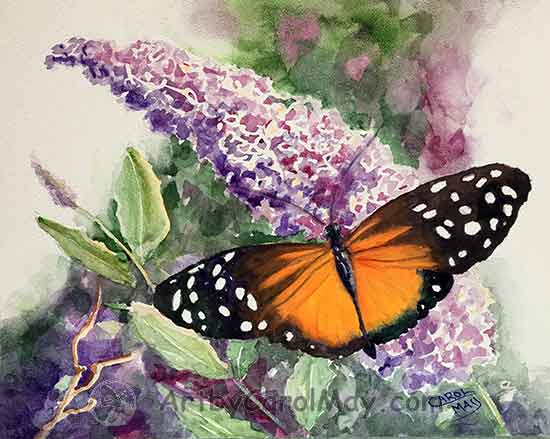- Home
- Art Terms
art terms used by today's painting artists
Painting has its own art terms of the styles, materials and techniques. Art is a universal language that transcends geographical borders and cultural barriers.
In the art world, every brush stroke and color scheme have significance.
The types of paint used, the medium
chosen, the composition and even the art supplies all have a role to
play in constructing the final piece of art.
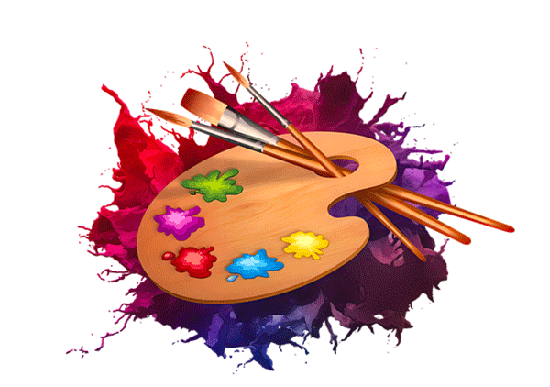 The Painting Art Lingo
The Painting Art LingoThis art glossary is divided into three sections: General Terms including color terms, Art Supplies, types of paint, what we paint on and brushes, then Painting Techniques for both oils and watercolor.
general art terms
In an artist's vocabulary, words like medium, sketch, foreground and composition all have unique meanings.
Knowing these art terms will allow you to appreciate and deepen your understanding of the world of painting art.
BACKGROUND looks the farthest away, usually toward the top of the painting.
COMPOSITION is the arrangement of the elements in a painting. Good composition makes a painting stand out from the others. It attracts the viewers to your painting.
FINE ART is the art term for beautiful art, as opposed to functional art such as pottery.
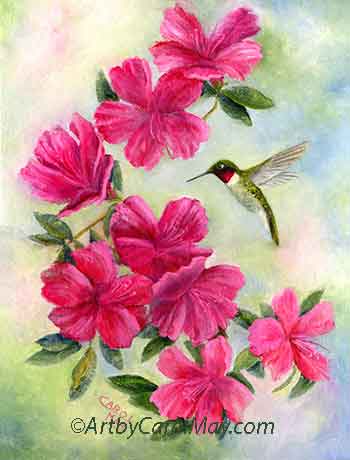 The hummer's the focal point.
The hummer's the focal point.FOCAL POINT or the focal area of a painting is what grabs the viewer's attention. It is the main subject of the painting.
How do we paint a focal point?
FOREGROUND is the part that looks the closest to the viewer, normally in the lower part of the painting.
MEDIUM is a substance mixed into paint to thicken, thin or otherwise alter the paint. Medium is also the type of art, such watercolor, oils, sculpture, drawing, etc.
MEDIA and MEDIUMS are both plural forms of medium.
MIXED MEDIA is two or more types of mediums used in one artwork.
SKETCH is a simple drawing without much detail.
VALUES refer to how light or dark a color is. Yellow is the lightest value color; purple is the darkest.
color terms
The joy of color is the reason many of us paint. Each art term opens up a new layer of understanding that makes our painting encounter richer and deeper.
ANALOGOUS COLORS are three or more colors next to each other on the color wheel.
COLOR WHEEL is a circular illustration of twelve colors and their relationship to each other.
COMPLIMENTARY COLORS are located directly across the color wheel from each other; yellow and violet, red and green, then blue and orange.
COOL COLORS are blue and green, and some violets are considered cool.
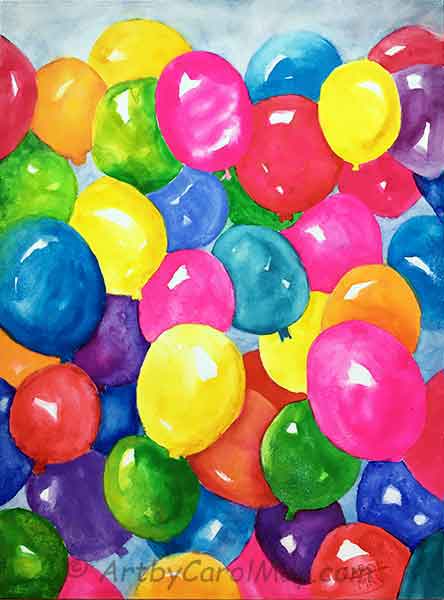 Color is the joy of painting.
Color is the joy of painting.HUE is the name of a color. For example, any blue color is a 'Blue Hue', reds are 'Red Hues', etc.
PRIMARY COLORS are red, yellow and blue. Primary colors cannot be mixed from any other colors.
SATURATION, CHROMA and INTENSITY all just means the color is more intense, brighter and pure.
SECONDARY COLORS are orange, purple and green, each are a mixture of two primary colors.
SHADE is obtained by mixing a color with black to make darker.
TERTIARY COLORS are six colors mixed from a secondary color and a primary color.
TINTS are obtained by mixing any color with white.
TONE is the purity of a color. Adding grey to a color lowers its tone.
WARM COLORS are red, yellow and orange. Get tips on using and mixing colors.
art terms for supplies
Exploring art supplies gives us a sense of what it takes to create a piece of art.
Supplies go beyond brushes and paints. They include everything from the canvas or paper to the palette.
PAINT PALETTE is the place to lay out your paints with space for mixing the colors.
Oil painters use a wood, glass or a disposable paper palette. Watercolor artists use ceramic, porcelain, plastic or disposable plates. Acrylic artists often use a disposable paper palette over a moisture retaining base.
Many artists place their palette into a covered container between painting sessions to keep the paint fresh.
Types of Art Paints
Various types of art paints have their own characteristics. They allow the artists to express themselves in a myriad of ways.
Art paints are made using color pigments. The substance used to carry the pigments is often the name of the type of paint.
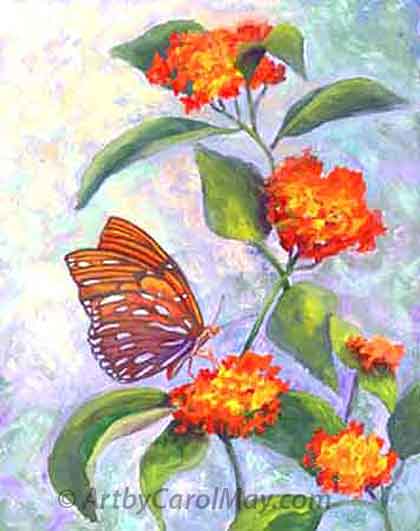 Casein butterfly painting
Casein butterfly paintingACRYLIC PAINT pigments are suspended in acrylic polymer. They are thinned with water and they dry very fast.
ALKYD PAINT has its pigments suspended in alkyd resin. Alkyds dry overnight and use the same solvents as oil paints.
ARTISTS PAINTS are professional paints that contain a substantial amount of color pigments.
CASEIN is a fast-drying paint, similar to egg tempura. However, it is manufactured with milk.
EGG TEMPERA paint pigments are mixed with egg
yolks. It water-soluble and dries quickly.
ENCAUSTIC paintings are created with melted wax. The medium is made with paint pigments mixed with beeswax and damar varnish.
GOUACHE is an opaque, water-based, fast drying medium often used for design work.
OIL PAINT pigments are suspended in linseed oil. They are slow drying and thinned with mineral spirits or turpentine.
PASTELS come in a stick or pan form. There are soft pastels and hard pastels depending upon how they are manufactured.
STUDENT PAINTS are less expensive because they contain less color pigment.
TEMPERA is a fast-drying paint often used in elementary schools.
WATERCOLOR PAINTS have their pigments suspended in gum Arabic. They are thinned and cleaned up with water.
painting supports
What the artist paints on is called a painting support. It can be made of paper, a panel, canvas, wood, plastic, glass or even metal.
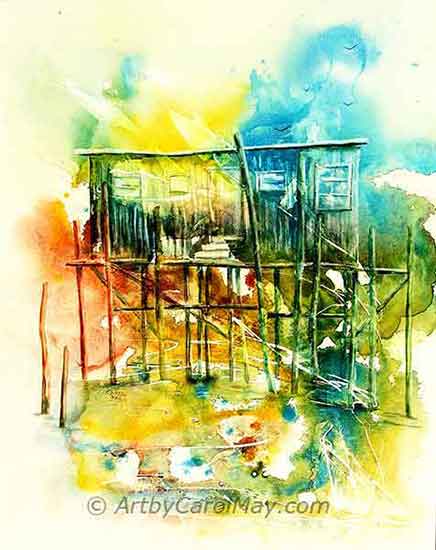 A painting on Aquabord
A painting on AquabordART PANELS are hardwood and pressed wood panels made for art.
CANVAS is the traditional support for oil and acrylic paintings.
The linen or cotton canvas is stretched around a wooden frame. Stretched canvas paintings last for years.
Now-a-days, there are watercolor canvases available.
CANVAS BOARDS have the canvas attached to a hard paper support. These are good for practice and student paintings, but they tend to warp with age.
CANVAS PADS are tablets paper that is textured and feel like canvas. They are good for color and composition studies.
CARBON PAPER is not suitable for transferring drawings to the painting support. It does not erase well and it can show thru in the final painting.
DRAWING PAPERS are usually made from wood pulp. Water will make them fall apart. But they are great for drawing.
GRAPHITE PAPER has graphite on the backside. It can be used for transferring your drawing to the painting surface.
NEWSPRINT is just like it sounds. It is recycled from newspapers. Use it for sketching out ideas and student work.
WATERCOLOR PAPER is normally made out of cotton. It is sized with rabbit glue to prevent the paint from soaking down into the paper.
It comes in different weights. 140# paper is common in tablets. It will buckle from a lot of water, so it will need to be stretched. 300# paper is heavier, it resists buckling and does not require stretching.
brushes: the artist's most important tool
Brushes exist in various forms, each with its unique purpose, like round brushes for detailed work, and flat brushes for filling larger areas.
Different mediums require different brushes.
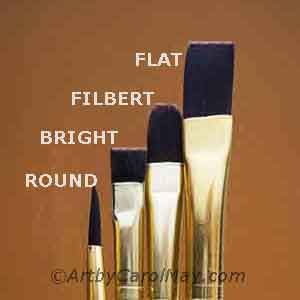 Artist paint brushes
Artist paint brushesACRYLIC BRUSHES are made from synthetic materials because water will make the natural hair bristles swell.
BRIGHTS are like a short bristled flat. The stroke of a bright tends to leave raised areas on the edge of the stroke.
FILBERT BRUSHES are a flat brush with rounded corners. They make a softer stroke without leaving raised edges.
FLAT BRUSHES have long bristles that carry a nice amount of paint.
Bright, filbert and flat brushes have their bristles
secured in a flat metal ferrule, normally on a wooden handle.
OIL PAINTING BRUSHES may be either stiff or soft.
The traditional hog hair brushes are stiff. They produce a painterly effect that is good for landscapes.
Animal hair brushes, like sable and synthetic brushes are softer. They are good for smoother work like portrait paintings.
RIGGER/SCRIPT LINER brushes are round brushes with extra-long bristles that make them flexible. They are good for painting fine lines such as tree branches.
ROUND BRUSHES have their bristles inserted into a round metal ferrule.
WATERCOLOR BRUSHES are sable or soft synthetic fibers.
Art terms for painting techniques
Artists use various techniques to create their unique styles.
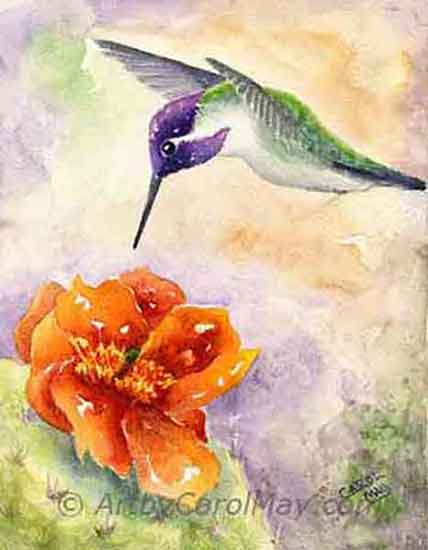 See the hard and soft Edges.
See the hard and soft Edges.Every technique used is a conscious choice, intended to create a specific impression or illusion in the art piece.
HARD AND SOFT EDGES occur during the painting process.
A hard edge is when the change from one color or value to another one is abrupt and sharp.
Hard edges attract the viewer's eye and are good in the focal area. Notice the hard edge on the hummingbird's head.
Soft edges are more gradual, softer transitions. They are created by blending the juncture of two different paint applications together.
Soft edges attract less attention, so they don't draw the eye away from the focal point. See the soft edge on the cactus leaf.
oil painting art terms
ALLA PRIMA is an art term for artwork that is painted 'wet into wet' paint. As opposed to waiting for a paint layer to dry before adding the next layer of paint.
Alla prima painting provides a chance to blend colors and edges while the paint is still workable.
GLAZING is done after one layer of paint is dry.
A thin, transparent color is painted over a previous dry layer. The bottom layer shows thru and the colors visually combine to produce a new color and/or value.
SCUMBLING is done over a previous dry layer of paint. The paint is used on a dry brush and rubbed on with the side of the brush. Opaque colors are normally used for scumbling. The original, dry layer still shows thru.
SPLATTERING may be done with oils, acrylic or watercolor.
Splatter paint off of a toothbrush or knock the paint off the brush by knocking the brush handle against the forefinger of the opposite hand.
Small droplets or pieces of paint fly onto the painting to create the desired effect, for example sand.
UNDERPAINTING is done in traditional oil painting where the painting is done in successive layers.
The first layer is painted thin to establish the color and value of each area of the painting. After the underpainting is dry, more layers are painted to complete the painting.
watercolor art terms
BLOOMS, BACK-RUNS or CAULIFLOWERS occur when we apply more paint to a previously painted area that is not dry.
The new paint will
run picking up the previous layer, collect and form an edge.
DRY BRUSHING in watercolor is done with a somewhat dry paint on dry paper. It produces a lot of texture, similar to scumbling in oil painting.
DRY WASH on dry paper produces crisp edges. As we move the paint with our brush, we have more control over the paint.
GLAZING is a layer of transparent paint painted over a previous dry layer of paint. Our eyes see a combination of the two layers of color.
MASKING FLUID or FRISKET is a rubbery type substance that may be applied to the watercolor support to resist paint.
Watercolors will not penetrate the areas covered with masking fluid. After the paint is dry, remove the masking fluid with a dry finger or a pick-up eraser.
WATERCOLOR WASH is paint and water mixed together and then applied over a large area.
WATERCOLOR WET WASH is paint applied to a wet surface. The paint moves smoothly covering a large area such as painting a sky.
Dampen the paper and mix the color ahead of time. Paint with smooth even strokes. The damp paper helps move paint and creates a smoother effect.
Congratulations!
With these art
terms safely in your tool belt, continue to explore more painting subjects on ArtbyCarolMay.com.
Remember, every stroke, every color, every term
used is a powerful tool to communicate your unique artistic voice.
